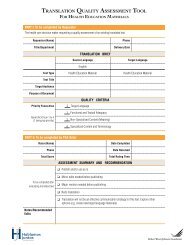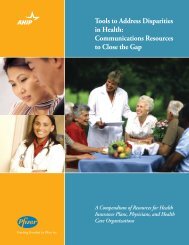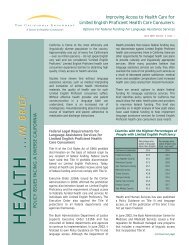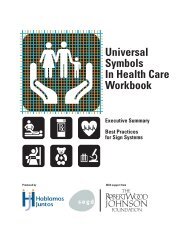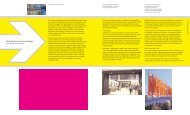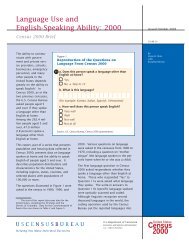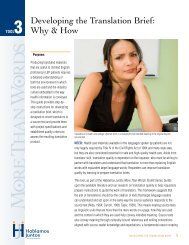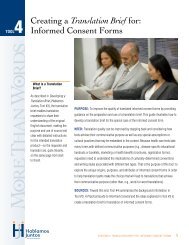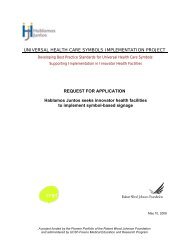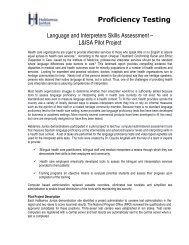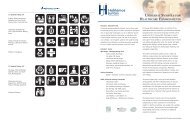Assessing Translation Quality - Hablamos Juntos
Assessing Translation Quality - Hablamos Juntos
Assessing Translation Quality - Hablamos Juntos
You also want an ePaper? Increase the reach of your titles
YUMPU automatically turns print PDFs into web optimized ePapers that Google loves.
Tool6<br />
<strong>Assessing</strong> <strong>Translation</strong> – A Manual<br />
for Requesters<br />
MORE THAN WORDS<br />
Purpose:<br />
The primary purposes of this tool<br />
are to enable requesters to use the<br />
<strong>Translation</strong> <strong>Quality</strong> Assessment<br />
(TQA) Tool and to describe why<br />
this promising method of quality<br />
assessment is superior to other<br />
approaches now in use. Tool #6<br />
is a practical how-to manual for<br />
requesters to initiate an evaluation<br />
of a translated text using the<br />
TQA Tool. It describes how TQA<br />
raters (professionals and/or<br />
academics with advanced language<br />
skills) use the tool to evaluate<br />
the quality of a translation and<br />
the recommendations they can<br />
make. This guide also acquaints<br />
requesters with the various<br />
methods and approaches used in<br />
evaluating translated materials,<br />
as well as those incorporated in<br />
the tool design. Also included<br />
are highlights about how the TQA<br />
Tool was tested and guidelines for<br />
selecting raters with whom to work.<br />
Notes/Recommended<br />
Edits<br />
PART I: To be completed by Requester<br />
The health care decision maker requesting a quality assessment of an existing translated text.<br />
Requester (Name) Phone<br />
Title/Department Delivery Date<br />
Priority Focus Area 2 Target Language<br />
Source Language Target Language<br />
English<br />
Text Type Health Education Material Health Education Material<br />
Text Title<br />
Target Audience<br />
Purpose of Document<br />
Rank EACH from 1 to 4<br />
(1 being top priority)<br />
PART II: To be completed by TQA Rater<br />
1 Functional and Textual Adequacy<br />
3 Non-Specialized Content (Meaning)<br />
4 Specialized Content and Terminology<br />
Rater (Name) Date Completed<br />
To be completed after<br />
evaluating translated text<br />
TranslaTion QualiTy assessmenT Tool<br />
Phone Date Received<br />
Total Score Total Rating Time<br />
ASSESSMENT SUMMARY AND RECOMMENDATION<br />
q Publish and/or use as is<br />
q Minor edits needed before publishing*<br />
q Major revision needed before publishing*<br />
q Redo translation<br />
For HealTH educaTion maTerials<br />
TRANSLATION BRIEF<br />
QUALITY CRITERIA<br />
q <strong>Translation</strong> will not be an effective communication strategy for this text. Explore other<br />
options (e.g. create new target language materials)<br />
Need: Generally speaking, those responsible for procuring translated materials in a<br />
health care setting often have little or no knowledge of the intricacies of translation.<br />
Consequently, poor quality translations are commonplace in health care organizations<br />
as well as in publicly-trusted sources of information like federal public health agencies<br />
and the Library of Medicine websites. Although health care organizations are aware of<br />
regulatory and accreditation compliance issues regarding translation and are becoming<br />
more aware of the impact of language barriers on operations and quality efforts, few<br />
have developed defined systems or processes for procuring or assessing the quality of<br />
translated materials.<br />
Further troubling is the fact that current approaches to translation quality are only<br />
somewhat applicable to (and therefore less than ideal for) health care organizations.<br />
Some approaches focus on the steps taken to produce a translated text or emphasize<br />
producing an English equivalent, while others focus on both the process and<br />
faithfulness to the original English text. A divergence of definitions of quality and a lack<br />
of consensus among experts also hinder progress in this area. In the end, health care<br />
organizations pay a lot of money for translated materials of dubious quality.<br />
Using the <strong>Translation</strong> <strong>Quality</strong> Assessment Tool – A Training Manual for Requesters 1
Tool6<br />
With rapid growth in the LEP population, health care providers have a growing need for<br />
trustworthy and effective health information in the language of their patients. They need<br />
an efficient means of scrutinizing the quality of health care translations and assessment<br />
methods that go beyond a simple “good” or “bad” label. The TQA Tool offers health care<br />
providers evaluations with sufficient and detailed information in non-technical terms about<br />
the quality of a translation product, and if translation deficiencies exist, how they might<br />
affect intended communicative objectives.<br />
Who Should Use This Guide: This guide is meant for requesters, individuals,<br />
departments and organizations responsible for approving translations within their<br />
organizations. This tool explains how to complete Part I of the TQA Tool Cover Sheet,<br />
which is designed to orient a TQA rater to a specific rating assignment and establish<br />
quality criteria for the evaluation. Although raters with advanced linguistic skills are needed<br />
to apply the TQA Tool and render an opinion on translation quality, the evaluation process<br />
begins with a requester interested in assessing the quality of a specific translation product.<br />
How to Use This Guide:<br />
The <strong>Hablamos</strong> <strong>Juntos</strong> More Than Words<br />
Toolkit Series offers health care decision<br />
makers practical tools to become<br />
informed requesters and purchasers<br />
of non-English materials. A key<br />
message of the series is that translation<br />
quality requires a partnership between<br />
requesters and translators.<br />
Sections 1 and 2: About the TQA Tool<br />
Begin by reading Sections 1 and 2 to learn about the TQA Tool, how quality is defined and<br />
how the tool is constructed.<br />
Section 3: How to Use the TQA Tool<br />
Next read Section 3 for a step-by-step review of the instructions for using the tool, how to<br />
complete Part I of the Cover Page and how to select raters with whom to work.<br />
Section 4: Finding TQA Raters<br />
Finally, Section 4 provides an overview of how to find and hire a qualified rater to apply<br />
the TQA Tool, including an overview of the training they should have and the fees raters<br />
are likely to charge for a quality assessment. Online training to become a TQA rater is also<br />
available through <strong>Hablamos</strong> <strong>Juntos</strong> for any professional and/or academic with advanced<br />
language skills.<br />
Using the <strong>Translation</strong> <strong>Quality</strong> Assessment Tool – A Training Manual for Requesters 2
Tool6<br />
“<br />
The aim of the tool is to give<br />
requesters and health care decision<br />
makers a general overview of the<br />
quality of a translation product<br />
(i.e., the assessment purpose is<br />
summative).<br />
“<br />
Section 1. General Characteristics of the TQA Tool<br />
The TQA Tool, a four-page rating sheet, is a unique and ground-breaking approach<br />
to evaluation of translations. The tool, grounded in translation theory, builds on the<br />
experience of existing translation quality assessment approaches and is designed to<br />
overcome known limitations (e.g., arbitrary point systems, narrow evaluation foci).<br />
The tool draws on functionalist theory and textual and theoretical models that focus on the<br />
reader’s response, practical aspects and linguistic features of the translated text, and the<br />
relationship of the translation to the source text. Functionalist approaches recognize the role<br />
of extra-linguistic features (those not included within the realm of language) and promote<br />
the idea that the form (text type) and function or purpose and use of a target language<br />
text is of paramount importance in determining translation quality. Evaluations conducted<br />
by professionals with advanced language skills, trained to use the TQA Tool take into<br />
consideration various aspects emphasized in other current approaches to<br />
translation quality.<br />
RATING INSTRUCTIONS:<br />
5. Now read the English original<br />
3: Non-Specialized Content – (Meaning)<br />
Category<br />
Number<br />
Description<br />
The translation reflects or contains important unwarranted deviations from the original. It contains inaccurate<br />
3.a renditions and/or important omissions and additions that cannot be justified by the instructions. Very defective<br />
comprehension of the original text.<br />
There have been some changes in meaning, omissions or/and additions that cannot be justified by the<br />
3.b<br />
translation instructions. <strong>Translation</strong> shows some misunderstanding of original and/or translation instructions.<br />
3.c Minor alterations in meaning, additions or omissions.<br />
The translation accurately reflects the content contained in the original, insofar as it is required by the<br />
3.d instructions without unwarranted alterations, omissions or additions. Slight nuances and shades of meaning<br />
have been rendered adequately.<br />
Examples/Comments<br />
4: Specialized Content and Terminology<br />
Category<br />
Number<br />
RATING INSTRUCTIONS:<br />
1. Carefu ly read the instructions for the review of the translated text. Your decisions and evaluation should be based on these instructions only.<br />
2. Check the description that best fits the text given in each one of the categories.<br />
1: Target Language<br />
Category<br />
Number<br />
1. a<br />
1.b<br />
1.c<br />
Description<br />
4.a Reveals unawareness/ignorance of special terminology and/or insufficient knowledge of specialized content.<br />
1.d<br />
Examples/Comments<br />
4.b Serious/frequent mistakes involving terminology and/or specialized content.<br />
4.c A few terminological errors, but the specialized content is not seriously affected.<br />
Accurate and appropriate rendition of the terminology. It reflects a good command of terms and content specific<br />
4.d<br />
to the subject.<br />
Examples/Comments<br />
Check<br />
one box<br />
Description<br />
The text is extremely difficul to read, bordering on being incomprehensible. The translation reveals serious<br />
language proficiency issues. Ungrammatical use of the target language, spe ling mistakes. The translation is<br />
written in some sort of ‘mixed language’ (neither the source nor the target). The structure of source language<br />
dominates to the extent that it cannot be considered a sample of target language text. The amount of transfer<br />
from the source cannot be justified by the purpose of the translation.<br />
The text is hard to comprehend. The text contains some unnecessary transfer of elements/structure from the<br />
source text. The structure of the source language shows up in the translation and affects its readability.<br />
Although the targe text is generaly readable, there are problems and awkward expressions resulting, in most<br />
cases, from unnecessary transfer from the source text.<br />
The translated text reads similarly to texts originaly written in the target language that respond to the<br />
same purpose, audience and tex type as those specified for the translation in the brief. Problems/awkward<br />
expressions are minimal if existent at a l.<br />
2: Functional and Textual Adequacy<br />
Category<br />
Number<br />
2.a<br />
2.b<br />
2.c<br />
2.d<br />
Examples/Comments<br />
Check<br />
one box<br />
Description<br />
Tally Sheet<br />
3. It is recommended that you read the targe text without looking a the English and score the Target Language and Functional categories.<br />
4. Examples or comments are not required, bu they can be useful to make decisions or to provide rationale for your descriptor selection.<br />
Target<br />
Language<br />
Disregard for the goals, purpose, function and audience of the text. The text was translated without considering<br />
textual units, textual purpose, genre, need of the audience, (cultural, linguistic, etc.). Can not be repaired with<br />
revisions.<br />
The translated text gives some consideration to the intended purpose and audience for the translation, but<br />
misses some important aspect/s of it (e.g. level o formality, some aspect of its function, needs of the audience,<br />
cultural considerations, etc.). Repai requires effort.<br />
The translated text approximates to the goals, purpose (function) and needs of the intended audience, but it is<br />
not as efficient as it could be, given the restrictions and instructions for the translation. Can be repaired with<br />
suggested edits.<br />
The translated text accurately accomplishes the goals, purpose (function: informative, expressive, persuasive)<br />
set for the translation and intended audience (including level o formality). It also attends to cultural needs and<br />
characteristics of the audience. Minor or no edits needed.<br />
Component Category Rating Score Value<br />
Functional and Textual<br />
Adequacy<br />
Non-Specialized<br />
Content<br />
Specialized Content<br />
and Terminology<br />
Comments<br />
Check<br />
one box<br />
Check<br />
one box<br />
PART I: To be completed by Requester<br />
The health care decision make requesting a quality assessment of an existing translated text.<br />
Requester (Name) Phone<br />
Title/Department Delivery Date<br />
Total Score<br />
Priority Focus Area 2 Target Language<br />
Source Language Target Language<br />
English<br />
Text Type Health Education Material Health Education Material<br />
Text Title<br />
Target Audience<br />
Purpose of Document<br />
Rank EACH from 1 to 4<br />
(1 being top priority)<br />
1 Functional and Textual Adequacy<br />
3 Non-Specialized Content (Meaning)<br />
4 Specialized Content and Terminology<br />
Rater (Name) Date Completed<br />
Phone Date Received<br />
Total Score Total Rating Time<br />
To be completed after<br />
evaluating translated text<br />
Notes/Recommended<br />
Edits<br />
Tr anslaTion Qua l i Ty assessmenT Tool<br />
PART II: To be completed by TQA Rater<br />
For HealTH educaTion maTerials<br />
q Publish and/or use as is<br />
q Minor edits needed before publishing*<br />
q Majo revision needed before publishing*<br />
q Redo translation<br />
TRANSLATION BRIEF<br />
QUALITY CRITERIA<br />
ASSESSMENT SUMMARY AND RECOMMENDATION<br />
q <strong>Translation</strong> wi l not be an effective communication strategy for this text. Explore other<br />
options (e.g. create new target language materials)<br />
A Compositional Tool<br />
The TQA Tool uses four categories of assessment, with each component emphasizing a<br />
different aspect of translation quality. In this regard, the TQA Tool is a compositional tool<br />
designed to evaluate the four key aspects of any translation. These components include:<br />
›› Target Language – an examination of the quality of the translation’s linguistic form<br />
(e.g., spelling, grammar, lexicon)<br />
›› Textual and Functional Adequacy – a consideration of how well the translation<br />
achieves the goals, purpose and function of the text for its target audience<br />
›› Non-Specialized Content – an assessment of whether the content accurately<br />
reflects the original text.<br />
›› Specialized Content – an appraisal of translation accuracy of special terminology<br />
and/or specialized content.<br />
Using the <strong>Translation</strong> <strong>Quality</strong> Assessment Tool – A Training Manual for Requesters 3
Tool6<br />
“<br />
In evaluating the quality of a<br />
translated text, raters are instructed<br />
to not only look at the linguistic<br />
sub-units, but also to how well<br />
the text achieves its overall<br />
communicative purpose.<br />
“<br />
“<br />
Requesters need an efficient means<br />
of scrutinizing the quality of health<br />
care translations and assessment<br />
methods that go beyond a simple<br />
“good” or “bad” label.<br />
“<br />
The aim of the tool is to give requesters and health care decision makers a general<br />
overview of the quality of a translation product (i.e., the assessment purpose is<br />
summative). Requesters receive from TQA raters a summary evaluation of the translation’s<br />
overall quality in the form of a recommendation about the adequacy of the translation.<br />
The object of assessment is the product, or the translated text. The goal is not to determine<br />
why the translator made a certain mistake, but rather what effects the mistake has on the<br />
text and its intended meaning. Although the TQA Tool has been tested specifically with<br />
health care education materials, it can also be used to evaluate other translation types.<br />
A Textual Approach<br />
The TQA Tool uses a textual approach to evaluation, meaning that texts are seen as whole<br />
units, comprised of smaller linguistic sub-units (words, headings, sentences, paragraphs).<br />
The basic premise of an evaluation is that texts are organized in a particular way to achieve<br />
a defined function (to educate, inform, explain) within a particular purpose for an intended<br />
audience (communicative context). In this regard, texts are the result of the writer’s<br />
assumptions about the audience, as well as the audience’s contributions within a particular<br />
communicative context (usually in the form of previous knowledge, attitudes or beliefs). The<br />
translator must work to recreate the text for a new target audience, which is often different<br />
from the audience envisioned by the author of the original text, and for a new communicative<br />
context which is sometimes in conflict with that of the original (Colina 2003).<br />
Simply put, translated texts are not independent or objective entities. The same text can<br />
be translated in different ways depending on the communicative context of the target text<br />
or the assumptions made about the audience. In evaluating the quality of a translated text,<br />
raters are instructed to not only look at the linguistic sub-units, but also to how well the text<br />
achieves its overall communicative purpose. In other words, does an educational brochure<br />
work as such; does an ad sound like an ad and function like one Finally, translation errors<br />
are not considered isolated linguistic or grammatical errors (e.g., agreement, conjugations,<br />
use of tense and mood with verbs, lexical choices) but instead should be evaluated based<br />
on the overall effect they have on the text and its communicative function.<br />
Descriptive Statements for Classification<br />
Rather than using a system where points are assessed for each error, somewhat arbitrarily,<br />
the TQA Tool uses descriptive statements to classify texts into one of four assessment<br />
categories. Each descriptor defines the degree of compliance with specific criteria. Raters<br />
evaluate text by matching their assessment to a descriptive statement for each evaluation<br />
category. The goal is to choose the statement that best describes the text in each of area<br />
of evaluation. Descriptors reflect a four-point range, from unacceptable to ideal, for each<br />
component evaluated.<br />
Using the <strong>Translation</strong> <strong>Quality</strong> Assessment Tool – A Training Manual for Requesters 4
Tool6<br />
TQA Tool Rating Section<br />
RATING INSTRUCTIONS:<br />
1. Carefully read the instructions for the review of the translated text. Your decisions and evaluation should be based on these instructions only.<br />
2. Check the description that best fits the text given in each one of the categories.<br />
3. It is recommended that you read the target text without looking a the English and score the Target Language and Functional categories.<br />
4. Examples or comments are not required, but they can be useful to make decisions or to provide rationale for your descriptor selection.<br />
1: Target Language<br />
Category<br />
Check<br />
Description<br />
Number<br />
one box<br />
The text is extremely difficult to read, bordering on being incomprehensible. The translation reveals serious<br />
language proficiency issues. Ungrammatical use of the target language, spelling mistakes. The translation is<br />
1.a written in some sort of ‘mixed language’ (neither the source nor the target). The structure of source language<br />
dominates to the extent that it cannot be considered a sample of target language text. The amount of transfer<br />
from the source cannot be justified by the purpose of the translation.<br />
The text is hard to comprehend. The text contains some unnecessary transfer of elements/structure from the<br />
1.b<br />
source text. The structure of the source language shows up in the translation and affects its readability.<br />
Although the target text is generally readable, there are problems and awkward expressions resulting, in most<br />
1.c<br />
cases, from unnecessary transfer from the source text.<br />
The translated text reads similarly to texts originally written in the target language that respond to the<br />
1.d same purpose, audience and text type as those specified for the translation in the brief. Problems/awkward<br />
expressions are minimal if existent at all.<br />
Examples/Comments<br />
2: Functional and Textual Adequacy<br />
Category<br />
Check<br />
Description<br />
Number<br />
one box<br />
Disregard for the goals, purpose, function and audience of the text. The text was translated without considering<br />
2.a textual units, textual purpose, genre, need of the audience, (cultural, linguistic, etc.). Can not be repaired with<br />
revisions.<br />
The translated text gives some consideration to the intended purpose and audience for the translation, but<br />
2.b misses some important aspect/s of it (e.g. level of formality, some aspect of its function, needs of the audience,<br />
cultural considerations, etc.). Repair requires effort.<br />
The translated text approximates to the goals, purpose (function) and needs of the intended audience, but it is<br />
2.c not as efficient as it could be, given the restrictions and instructions for the translation. Can be repaired with<br />
suggested edits.<br />
The translated text accurately accomplishes the goals, purpose (function: informative, expressive, persuasive)<br />
2.d set for the translation and intended audience (including level of formality). It also attends to cultural needs and<br />
characteristics of the audience. Minor or no edits needed.<br />
Examples/Comments<br />
RATING INSTRUCTIONS:<br />
5. Now read the English original<br />
3: Non-Specialized Content – (Meaning)<br />
Category<br />
Check<br />
Description<br />
Number<br />
one box<br />
The translation reflects or contains important unwarranted deviations from the original. It contains inaccurate<br />
3.a renditions and/or important omissions and additions that cannot be justified by the instructions. Very defective<br />
comprehension of the original text.<br />
There have been some changes in meaning, omissions or/and additions that cannot be justified by the<br />
3.b<br />
translation instructions. <strong>Translation</strong> shows some misunderstanding of original and/or translation instructions.<br />
3.c Minor alterations in meaning, additions or omissions.<br />
The translation accurately reflects the content contained in the original, insofar as it is required by the<br />
3.d instructions without unwarranted alterations, omissions or additions. Slight nuances and shades of meaning<br />
have been rendered adequately.<br />
Examples/Comments<br />
4: Specialized Content and Terminology<br />
Category<br />
Check<br />
Description<br />
Number<br />
one box<br />
4.a Reveals unawareness/ignorance of special terminology and/or insufficient knowledge of specialized content.<br />
4.b Serious/frequent mistakes involving terminology and/or specialized content.<br />
4.c A few terminological errors, but the specialized content is not seriously affected.<br />
Accurate and appropriate rendition of the terminology. It reflects a good command of terms and content specific<br />
4.d<br />
to the subject.<br />
Examples/Comments<br />
›› Target Language – The text is: 1) extremely difficult to read (incomprehensible);<br />
2) hard to comprehend, (includes elements/structure from the source text);<br />
3) generally readable but with awkward expressions; or 4) reads similar to texts<br />
originally written in the target language.<br />
›› Textual and Functional Adequacy – The text: 1) does not consider the goals,<br />
purpose, function and audience (cannot be repaired); 2) gives some consideration to<br />
the intended purpose and audience (repair will require considerable effort);<br />
3) approximates goals, purpose, function and needs of the intended audience (can be<br />
repaired with edits); or 4) accurately accomplishes the goals, purpose, and function of<br />
the original (minor or no edits needed).<br />
›› Non-Specialized Content – The text: 1) contains important unwarranted deviations<br />
from the original (very defective); 2) exhibits some misunderstanding of the original<br />
and/or the translation instruction; 3) minor alterations in meaning, additions or<br />
omissions; or 4) accurately reflects the content contained in the original.<br />
›› Specialized Content – The text: 1) reveals an unawareness/ignorance of special<br />
terminology and/or insufficient knowledge of specialized content; 2) contains serious/<br />
frequent mistakes involving terminology and/or specialized content; 3) has a few<br />
terminological errors, but the specialized content is not seriously affected; or<br />
4) is accurate and appropriate.<br />
During the evaluation process, the translation is examined four times. Each time, a rater<br />
looks to match the text to the best description in each of the four categories. However,<br />
raters are instructed to first assess the translation for Target Language and Textual and<br />
Functional Adequacy without looking at the English original text. This enables raters to<br />
capture a first impression, as the target reader is likely to gain from reading the translation<br />
without reference to the source text.<br />
Raters are then asked to read the source text, contrasting the translation with the source<br />
text and then with their first impressions as a target reader. This step is vital as a measure<br />
of how well a translation anticipates and honors the communicative context of intended<br />
target audiences. Consequently, raters may need to adjust their first rating before<br />
continuing the assessment for the final two categories – Non-Specialized Content and<br />
Specialized Content. With each rating component, raters emphasize a different aspect of<br />
translation quality during their assessment. Considering all four aspects raters are then<br />
ready to make a recommendation about the translation.<br />
Using the <strong>Translation</strong> <strong>Quality</strong> Assessment Tool – A Training Manual for Requesters 5
Tool6<br />
Section 2. Concept of <strong>Quality</strong> – <strong>Translation</strong>s in Health Care<br />
Understanding what constitutes quality in a health care text that has been translated from<br />
one language to another was the first area of research while developing the TQA Tool.<br />
Through an extensive review of translation assessment methods, it became clear that most<br />
researchers and practitioners familiar with the literature on translation evaluation agree that<br />
there is a lack of assessment standards. The various methods for assessing translation<br />
quality fall into three basic categories:<br />
›› Procedural quality assurance systems<br />
›› Experience-based or anecdotal approaches<br />
›› Theoretical and research-based approaches<br />
Procedural quality assurance systems are those developed primarily by the translation<br />
industry and organizations recognized as the standard bearers in the field (e.g., ASTM<br />
International, ISO or International Organizations for Standardization), as well as those<br />
developed by private translation production firms. Experience-based or anecdotal<br />
approaches consist of point systems or marking and ad hoc scales (where points<br />
are deducted for major or minor errors) developed to measure quality for a specific<br />
professional organization or industry. Among these are the American Translators<br />
Association certification exams, used to assess translator competencies, and the SAE<br />
J2450 <strong>Translation</strong> <strong>Quality</strong> Metric system, which is used by the automotive industry.<br />
Theoretical and research-based approaches tend to focus on the user of a translation,<br />
evaluating reader response of the text, and closely examining the micro-level aspects of<br />
language. Each approach emphasizes an important aspect of quality and all enjoy some<br />
degree of success and applicability.<br />
“<br />
Definition of quality:<br />
“Anticipate and honor the need<br />
of an intending user”<br />
Source: Six Sigma Website<br />
“<br />
Overarching is the premise that how a text is organized, down to the words chosen, is<br />
influenced by how that language achieves successful communication. However, words on<br />
a page, the more obvious linguistic or micro-level features of language, are only part of the<br />
picture. <strong>Assessing</strong> the quality of written language also requires taking into consideration<br />
the wider panorama of the communicative purpose of a text, the content, context and the<br />
intended audience.<br />
Written materials can be a valuable communication tool to help consumers take a more<br />
active role in their health care, but only if the patients are able to read and understand<br />
the information. With this in mind, translation quality needs to emphasize the relevance<br />
of a translation to the user. The TQA Tool is designed to measure quality by how well a<br />
translation meets the communicative purpose of the original text while anticipating and<br />
honoring the needs of the intended target language user (e.g., LEP patients). This definition<br />
of quality emphasizes the significance of creating translation products that accommodate<br />
the intended user while remaining loyal to the original meaning of the source text.<br />
Using the <strong>Translation</strong> <strong>Quality</strong> Assessment Tool – A Training Manual for Requesters 6
Tool6<br />
“<br />
Several rounds of testing in three<br />
languages – Spanish, Chinese<br />
and Russian – and involving 52<br />
raters (translators, language<br />
professionals, and bilinguals)<br />
were conducted with the TQA<br />
Tool using publicly-available<br />
health care materials (e.g., CDC,<br />
Medline Plus En Español etc.).<br />
“<br />
Has the tool been tested<br />
Several rounds of testing in three languages – Spanish, Chinese and Russian – and<br />
involving 52 raters (translators, language professionals, and bilinguals) were conducted<br />
with the TQA Tool using publicly-available health care materials (e.g., CDC, Medline Plus<br />
En Español etc.). TQA Tool testing consisted of a pilot testing phase and a two-phase<br />
inter-rater reliability testing process. The pilot testing which included 22 raters and 9 texts<br />
is described elsewhere (Colina 2008). Language consultants, highly-skilled translators<br />
in each of the three languages participated in the pilot testing session and helped identify<br />
texts for a two-phase inter-rater reliability testing phase. The inter-rater reliability testing<br />
process included 30 raters, 3 consultants and 13 texts. Each round of testing was followed<br />
by a debriefing session with raters that included a structured survey about the rating<br />
experience. Quantitative data obtained from ratings using the tool and post-rating surveys<br />
were subjected to statistical analysis to determine inter-rater reliability. Qualitative data<br />
collected from raters in the post-rating surveys were also analyzed.<br />
As shown in the table below, the inter-rater reliability coefficients among the Spanish<br />
and Chinese raters respectively, are quite good and statistically significant. Benchmark<br />
testing included 12 raters: three Russian, three Chinese, and six Spanish. In the reliability<br />
testing session, 21 raters were included: six Russian, seven Chinese, and eight Spanish.<br />
As shown, the results of reliability testing for the Chinese raters achieved an acceptable<br />
inter-rater reliability coefficient although lower than in the Benchmark testing. Inconsistent<br />
and wide variability in ratings among the Russian raters, compared to the Spanish and the<br />
Chinese raters, led us to believe other unknown factors unrelated to the tool were present.<br />
Further testing for Russian raters and other languages is needed.<br />
Inter-rater reliability: Benchmark and Reliability Testing Results<br />
Benchmark Testing<br />
(12 Raters)<br />
Reliability Coefficient<br />
Reliability Testing<br />
(21 Raters)<br />
Spanish .953 .934<br />
Chinese .973 .780<br />
Russian .128 .118<br />
Using the <strong>Translation</strong> <strong>Quality</strong> Assessment Tool – A Training Manual for Requesters 7
Tool6<br />
“ TranslaTion QualiTy assessmenT Tool<br />
For HealTH educaTion maTerials<br />
PART I: To be completed by Requester<br />
The health care decision maker requesting a quality assessment of an existing translated text.<br />
Requester (Name)<br />
Title/Department<br />
Phone<br />
Delivery Date<br />
“<br />
Requesters begin a translation<br />
quality assessment by completing<br />
Part I of the TQA Tool Cover Page.<br />
Section 3. How to Complete Part I of the TQA Tool<br />
The TQA Tool is used either after a translation project is complete (as part of the acceptance<br />
process) or to determine the quality of an existing target language text. Requesters begin a<br />
translation quality assessment by completing Part I of the TQA Tool Cover Page. This part<br />
of the Cover Page is used to formalize a request, set a delivery date and orient raters to the<br />
text to be evaluated. It is also used to prioritize each quality criteria.<br />
Step 1: Provide contact information and establish a deadline<br />
for the quality review<br />
Contact Information and Deadline<br />
Requester (Name)<br />
Title/Department<br />
Phone<br />
Delivery<br />
Date<br />
TRANSLATION BRIEF<br />
Source Language<br />
Target Language<br />
English<br />
Text Type Health Education Material Health Education Material<br />
Text Title<br />
Target Audience<br />
Purpose of Document<br />
QUALITY CRITERIA<br />
Priority Focus Area 2 Target Language<br />
Rank EACH from 1 to 4<br />
1 Functional and Textual Adequacy<br />
(1 being top priority) 3 Non-Specialized Content (Meaning)<br />
4 Specialized Content and Terminology<br />
PART II: To be completed by TQA Rater<br />
Rater (Name)<br />
Date Completed<br />
Phone<br />
Date Received<br />
Total Score<br />
Total Rating Time<br />
ASSESSMENT SUMMARY AND RECOMMENDATION<br />
q Publish and/or use as is<br />
q Minor edits needed before publishing*<br />
To be completed after<br />
q Major revision needed before publishing*<br />
evaluating translated text<br />
q Redo translation<br />
q <strong>Translation</strong> will not be an effective communication strategy for this text. Explore other<br />
options (e.g. create new target language materials)<br />
Notes/Recommended<br />
Edits<br />
Step 2: Complete the basic elements of a translation brief<br />
The best translation evaluations are those where the rater has a detailed understanding<br />
of both the environment and communicative context (uses and purposes of a text) for<br />
which the source and target texts are used. Tool #3 in the More Than Words Toolkit Series<br />
introduces requesters to the practice of preparing a translation brief to accompany a<br />
translation request. The translation brief is a set of instructions that define the purpose and<br />
use of a source text and establish priorities to guide the translators in their preparation of<br />
the requested translation.<br />
Using Part I of the TQA Cover Page, requesters provide a translation brief orienting the<br />
rater to the text to be rated. This includes a brief description of the source text and those<br />
intended for the target text. As show below the translation brief for the TQA evaluation<br />
includes basic information about the source and target text, their respective purpose and<br />
use, and communicative context.<br />
<strong>Translation</strong> Brief Section<br />
TRANSLATION BRIEF<br />
Source Language<br />
Target Language<br />
English<br />
Text Type Health Education Material Health Education Material<br />
Text Title<br />
Target Audience<br />
Purpose of Document<br />
Using the <strong>Translation</strong> <strong>Quality</strong> Assessment Tool – A Training Manual for Requesters 8
Tool6<br />
›› Source-Target language. Fill in the source language for the original text (usually<br />
English) and target language for the translated text<br />
›› Text Type. Describe the text type (brochure, checklist, consent form)<br />
›› Text Title. Write the title of each text<br />
›› Target Audience: Write a description of the source and target audience (the idealized<br />
readers with regard to background and assumed interest). For example, nationwide or<br />
regional audience, with general characteristics or specific attributes (e.g., gender, age,<br />
occupation).<br />
›› Purpose of Document. Write the respective communicative purposes for each text<br />
(e.g., to inform, educate, collect information, fulfill a legal requirement).<br />
Step 3: Establish quality criteria<br />
The <strong>Quality</strong> Criteria section of Part I helps establish the requester’s priority for the<br />
evaluation. Each component of the tool represents an important aspect of quality.<br />
Considering what each of the four assessment areas represents enables the requester to<br />
determine whether one focus area should be of greater priority than the others. During the<br />
development phase of the TQA tool, a priority ranking was established for health education<br />
materials. This priority is noted in the table below.<br />
<strong>Quality</strong> Criteria Ranking for Health Education Materials<br />
QUALITY CRITERIA<br />
Priority Focus Area 2 Target Language<br />
Rank EACH from 1 to 4<br />
(1 being top priority)<br />
1 Functional and Textual Adequacy<br />
3 Non-Specialized Content (Meaning)<br />
4 Specialized Content and Terminology<br />
By permitting the most relevant components to be given a higher priority, the TQA Tool<br />
provides flexibility in establishing the quality criteria of each text to be evaluated. For<br />
example, Specialized Content and Terminology could be given a higher priority for texts<br />
with highly-specialized content whereas Functional and Textual Adequacy might take<br />
priority for health materials developed for general audiences.<br />
The tool can also be used without assigning priority rankings (i.e., all components<br />
could be given equal weight). Raters with advanced language education and translation<br />
experience can also offer recommendations for ranking the criteria for a specific text. With<br />
flexibility to set quality criteria, requesters and raters can use the tool in unique settings.<br />
Note, however, that additional research is needed to determine empirically the importance<br />
of each quality criterion for different text types.<br />
These three easy steps initiate a translation quality assessment. When a rating is completed,<br />
raters summarize their assessment and make recommendations on Part II of the Cover Page.<br />
Using the <strong>Translation</strong> <strong>Quality</strong> Assessment Tool – A Training Manual for Requesters 9
Tool6<br />
“<br />
Part II of the TQA Tool Cover Page<br />
is completed by raters, to provide<br />
requesters a summary of the<br />
assessment with recommendations<br />
that can range from ”publish the<br />
text as is” to “the translation is<br />
beyond repair.”<br />
“<br />
Part II – Rating Results<br />
Assessment Summary and Recommendation to be completed by TQA Raters<br />
Part II of the TQA Tool Cover Page is completed by raters, giving requesters a summary<br />
of the assessment with recommendations that can range from ”publish the text as is” to<br />
“the translation is beyond repair.” For translations that do not meet the highest quality<br />
standard, but are salvageable, raters can recommend edits. Raters can also note whether, in<br />
their professional judgment, discrepancies exist between the source and target audiences<br />
too great to overcome with a translation. They should also provide a summary of their<br />
observations, with examples of problems found and the type of edits they recommended.<br />
This can include notes made during their rating and/or explanation of their evaluation.<br />
Rater (Name)<br />
Phone<br />
Total Score<br />
TQA Tool Cover Page Part II<br />
Date Completed<br />
Date Received<br />
Total Rating Time<br />
ASSESSMENT SUMMARY AND RECOMMENDATION<br />
q Publish and/or use as is<br />
q Minor edits needed before publishing*<br />
To be completed after<br />
evaluating translated text<br />
q Major revision needed before publishing*<br />
q Redo translation<br />
q <strong>Translation</strong> will not be an effective communication<br />
strategy for this text. Explore other options (e.g. create<br />
new target language materials)<br />
Notes/<br />
Recommended<br />
Edits<br />
Section 4. A TQA Rater<br />
Professionals or academics with advanced knowledge of the target language and<br />
experience in translation can learn to apply the TQA Tool by reading the training manual.<br />
The concepts and demarcations of the descriptors used in the TQA Tool are sufficient for<br />
raters to differentiate high-quality and low-quality translations. Some variability is expected<br />
in the ratings of mid-range quality translations. Raters should be able to provide examples<br />
of minor or major errors as well as describe their findings in sufficient detail to help<br />
requesters understand the rating results and the types of deficiencies found.<br />
Using the <strong>Translation</strong> <strong>Quality</strong> Assessment Tool – A Training Manual for Requesters 10
Tool6<br />
Online training sessions are also available. These sessions review the underpinning of<br />
the tool, its design and how it is used to evaluate the quality of translated materials. All<br />
participants receive a training manual. A competency exam is also available to determine<br />
whether prospective raters understand and can apply the instructions as intended. Candidates<br />
successfully completing the training and online exam receive a certificate of completion.<br />
Rater Profiles<br />
Raters participating in the TQA Tool testing sessions were required to have a language<br />
proficiency equivalent to that of a native or near-native speaker in English and their second<br />
language (in this case, Spanish, Chinese or Russian). Raters were placed into one of three<br />
groups depending on their profile.<br />
Professional translators: Language professionals whose income is derived primarily<br />
from providing translation services. These raters had significant professional experience<br />
(five years minimum, most 12-20 years), membership in professional translation<br />
organizations and formal education in translation or related field. Although only two raters<br />
were ATA-certified, almost all were ATA-affiliates, if not members.<br />
Language teachers: Individuals, including graduate students, whose main occupation<br />
is teaching foreign language courses at a university or other educational institution. These<br />
raters had some translation experience but did not rely on translation as their primary<br />
source of income.<br />
Bilinguals: Individuals who, while native or near-native, did not have significant<br />
formal learning or writing proficiency in their target language (as a translator, teacher or<br />
otherwise). Community interpreters (e.g., medical interpreters, legal assistants) with no<br />
translation experience were also included in this category.<br />
The most proficient and consistent raters were those classified as professional translators,<br />
followed by the language teachers, although translation experience strongly correlated with<br />
rating consistency. Bilinguals were least able to apply the rating tool consistently.<br />
Requesters are encouraged to use raters who have taken the TQA Tool online training and<br />
qualify as either a professional translator or language teacher with substantive translation<br />
experience.<br />
How much does a TQA rating cost<br />
Payment for rating a translation is likely to vary based on word count and type of text. In<br />
each of the testing sessions, the amount of time raters took to assess a text was collected.<br />
Based on these data, the time taken to assess a text seemed to vary by rater. The hourly<br />
fees translators and language professionals charge for similar work also varies. Given<br />
these variables, requesters should expect to pay $35-50 for a text that is two to three pages<br />
in length, while longer texts will likely incur higher rates. Requests for corrections should<br />
be directed back to the original translator or negotiated separately with the rater.<br />
Using the <strong>Translation</strong> <strong>Quality</strong> Assessment Tool – A Training Manual for Requesters 11
Tool6<br />
This Guide was Produced by <strong>Hablamos</strong> <strong>Juntos</strong><br />
Since 2001, <strong>Hablamos</strong> <strong>Juntos</strong> (“We Speak Together”), a Robert Wood Johnson<br />
Foundation-funded national initiative, has been studying language barriers in health<br />
care for patients who speak or understand little or no English. In our years of work,<br />
the fundamental lesson we have learned is that communicating across languages and<br />
cultures involves more than words. It requires recognition that the meaning of ideas<br />
and words is conveyed and extracted through the cultural lens of the interlocutors<br />
and that these can be vastly different in cross-cultural communication. Attention to<br />
these differences is essential in effective communication, whether in writing through<br />
translation or spoken through interpretation.<br />
The <strong>Hablamos</strong> <strong>Juntos</strong> More Than Words Toolkit Series brings together lessons<br />
learned from demonstration projects - eight years of working with nationallyrecognized<br />
health care leaders and language experts - and from original research<br />
on translation quality. It has been made possible through the contributions of many<br />
around the country, including language faculty, researchers, practicing interpreters<br />
and translators, and health care professionals dedicated to providing safe and quality<br />
health care to our diverse nation. Among those requiring special mention for the<br />
production of Tool #6 are Sonia Colina, Yi Yuan, Aracely Rosales, Gauhar Nguyen and<br />
all of the TQA Raters.<br />
For more information about <strong>Hablamos</strong> <strong>Juntos</strong> or to download the entire More Than<br />
Words Toolkit Series, visit www.<strong>Hablamos</strong><strong>Juntos</strong>.org.<br />
The More Than Words Toolkit Series is copyright protected and may not be modified<br />
or changed without expressed written consent of <strong>Hablamos</strong> <strong>Juntos</strong>. Tools may be used<br />
without permission as long as <strong>Hablamos</strong> <strong>Juntos</strong> is recognized as the source.<br />
REFERENCES<br />
Colina, Sonia (2008). <strong>Translation</strong> quality evaluation; empirical evidence for a functionalist<br />
approach. In The Translator St Jerome Publishing Ltd (April) 14:1 (pp97-134)<br />
iSixSigma.com Website (2008). <strong>Quality</strong> Dictionary and Glossary. Accessed 2/12/2008 8:48 PM<br />
http://healthcare.isixsigma.com/dictionary/Definition_of_<strong>Quality</strong>-713.htm<br />
Copyright © 2009<br />
Using the <strong>Translation</strong> <strong>Quality</strong> Assessment Tool – A Training Manual for Requesters 12
TranslaTion QualiTy assessmenT Tool<br />
For HealTH educaTion maTerials<br />
PART I: To be completed by Requester<br />
The health care decision maker requesting a quality assessment of an existing translated text.<br />
Requester (Name)<br />
Title/Department<br />
Phone<br />
Delivery Date<br />
TRANSLATION BRIEF<br />
Source Language<br />
Target Language<br />
English<br />
Text Type Health Education Material Health Education Material<br />
Text Title<br />
Target Audience<br />
Purpose of Document<br />
QUALITY CRITERIA<br />
Priority Focus Area 2 Target Language<br />
Rank EACH from 1 to 4<br />
(1 being top priority)<br />
1 Functional and Textual Adequacy<br />
3 Non-Specialized Content (Meaning)<br />
4 Specialized Content and Terminology<br />
PART II: To be completed by TQA Rater<br />
Rater (Name)<br />
Phone<br />
Total Score<br />
Date Completed<br />
Date Received<br />
Total Rating Time<br />
ASSESSMENT SUMMARY AND RECOMMENDATION<br />
q Publish and/or use as is<br />
To be completed after<br />
evaluating translated text<br />
q Minor edits needed before publishing*<br />
q Major revision needed before publishing*<br />
q Redo translation<br />
q <strong>Translation</strong> will not be an effective communication strategy for this text. Explore other<br />
options (e.g. create new target language materials)<br />
Notes/Recommended<br />
Edits
Tally Sheet<br />
Target<br />
Language<br />
Component Category Rating Score Value<br />
Functional and Textual<br />
Adequacy<br />
Non-Specialized<br />
Content<br />
Specialized Content<br />
and Terminology<br />
Total Score<br />
Comments
RATING INSTRUCTIONS:<br />
1. Carefully read the instructions for the review of the translated text. Your decisions and evaluation should be based on these instructions only.<br />
2. Check the description that best fits the text given in each one of the categories.<br />
3. It is recommended that you read the target text without looking at the English and score the Target Language and Functional categories.<br />
4. Examples or comments are not required, but they can be useful to make decisions or to provide rationale for your descriptor selection.<br />
1: Target Language<br />
Category<br />
Number<br />
1.a<br />
1.b<br />
1.c<br />
1.d<br />
Description<br />
The text is extremely difficult to read, bordering on being incomprehensible. The translation reveals serious<br />
language proficiency issues. Ungrammatical use of the target language, spelling mistakes. The translation is<br />
written in some sort of ‘mixed language’ (neither the source nor the target). The structure of source language<br />
dominates to the extent that it cannot be considered a sample of target language text. The amount of transfer<br />
from the source cannot be justified by the purpose of the translation.<br />
The text is hard to comprehend. The text contains some unnecessary transfer of elements/structure from the<br />
source text. The structure of the source language shows up in the translation and affects its readability.<br />
Although the target text is generally readable, there are problems and awkward expressions resulting, in most<br />
cases, from unnecessary transfer from the source text.<br />
The translated text reads similarly to texts originally written in the target language that respond to the<br />
same purpose, audience and text type as those specified for the translation in the brief. Problems/awkward<br />
expressions are minimal if existent at all.<br />
Check<br />
one box<br />
Examples/Comments<br />
2: Functional and Textual Adequacy<br />
Category<br />
Number<br />
Description<br />
Check<br />
one box<br />
2.a<br />
2.b<br />
2.c<br />
2.d<br />
Disregard for the goals, purpose, function and audience of the text. The text was translated without considering<br />
textual units, textual purpose, genre, need of the audience, (cultural, linguistic, etc.). Can not be repaired with<br />
revisions.<br />
The translated text gives some consideration to the intended purpose and audience for the translation, but<br />
misses some important aspect/s of it (e.g. level of formality, some aspect of its function, needs of the audience,<br />
cultural considerations, etc.). Repair requires effort.<br />
The translated text approximates to the goals, purpose (function) and needs of the intended audience, but it is<br />
not as efficient as it could be, given the restrictions and instructions for the translation. Can be repaired with<br />
suggested edits.<br />
The translated text accurately accomplishes the goals, purpose (function: informative, expressive, persuasive)<br />
set for the translation and intended audience (including level of formality). It also attends to cultural needs and<br />
characteristics of the audience. Minor or no edits needed.<br />
Examples/Comments
RATING INSTRUCTIONS:<br />
5. Now read the English original<br />
3: Non-Specialized Content – (Meaning)<br />
Category<br />
Number<br />
Description<br />
Check<br />
one box<br />
3.a<br />
3.b<br />
The translation reflects or contains important unwarranted deviations from the original. It contains inaccurate<br />
renditions and/or important omissions and additions that cannot be justified by the instructions. Very defective<br />
comprehension of the original text.<br />
There have been some changes in meaning, omissions or/and additions that cannot be justified by the<br />
translation instructions. <strong>Translation</strong> shows some misunderstanding of original and/or translation instructions.<br />
3.c Minor alterations in meaning, additions or omissions.<br />
3.d<br />
The translation accurately reflects the content contained in the original, insofar as it is required by the<br />
instructions without unwarranted alterations, omissions or additions. Slight nuances and shades of meaning<br />
have been rendered adequately.<br />
Examples/Comments<br />
4: Specialized Content and Terminology<br />
Category<br />
Number<br />
Description<br />
Check<br />
one box<br />
4.a Reveals unawareness/ignorance of special terminology and/or insufficient knowledge of specialized content.<br />
4.b Serious/frequent mistakes involving terminology and/or specialized content.<br />
4.c A few terminological errors, but the specialized content is not seriously affected.<br />
4.d<br />
Examples/Comments<br />
Accurate and appropriate rendition of the terminology. It reflects a good command of terms and content specific<br />
to the subject.



